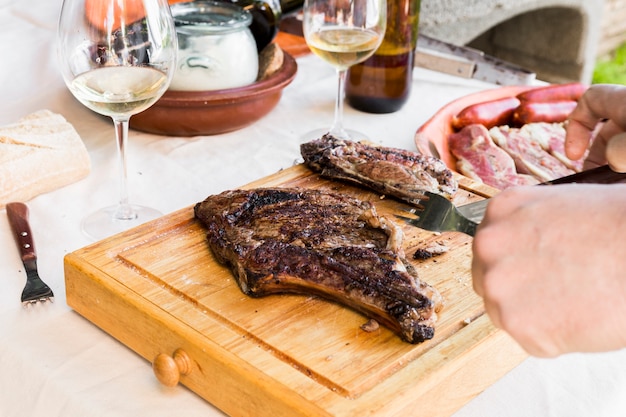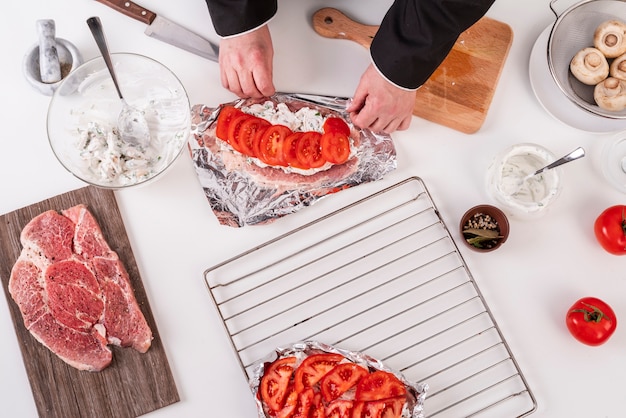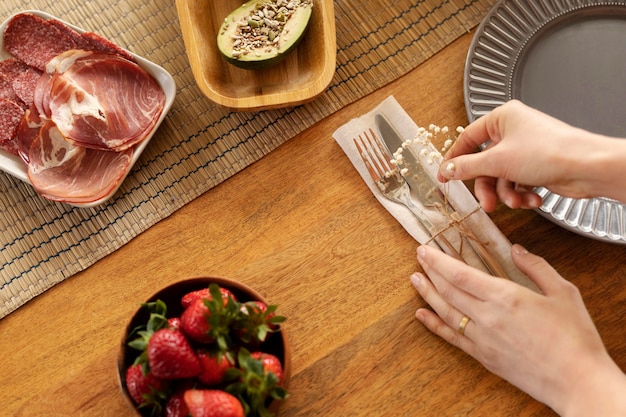Ah, the ny strip steak. Just the name conjures up images of juicy, tender meat, perfectly seared and seasoned, a culinary masterpiece waiting to be devoured. It's a cut that's become a classic for a reason. That beautiful marbling, the rich flavour, the satisfying chew – it's pure steak heaven. But, let's be honest, cooking a perfect NY strip steak isn't always a walk in the park. It's a delicate dance with heat, time, and a whole lot of attention to detail. I've had my fair share of steak disasters, believe me. Dry, overcooked, bland – I've seen it all. But over the years, with a bit of trial and error, and some invaluable advice from seasoned chefs, I've finally cracked the code. So, get ready to embark on a journey to steak perfection. This is your ultimate guide to cooking the best NY strip steak you've ever tasted. Buckle up, it's going to be delicious!
(Part 1) choosing the right steak: The Foundation of Success

You know the saying, "You can't make a silk purse out of a sow's ear?" Well, it applies to NY strip steak too. If you want a truly remarkable steak, you've got to start with the right cut of meat. This is where the adventure begins. And, it's an adventure I highly recommend you take with your local butcher. They are the experts, the wizards of meat, and they can help you pick the perfect piece for your culinary masterpiece.
The Golden Rules of steak selection
Here's the lowdown on what to look for when choosing your NY strip:
- Thickness is King: Aim for a steak that's at least an inch thick. This ensures even cooking and prevents it from getting overcooked before the inside reaches the perfect temperature. Anything thinner, and you'll be playing a risky game.
- Marbling is Your Friend: Those streaks of fat are your steak's secret weapon. They deliver that rich, juicy flavour, and contribute to a melt-in-your-mouth tenderness. Look for a steak with good marbling throughout – you don't want it looking dry or lean.
- Freshness is Essential: A good steak should have a bright, vibrant colour and a pleasant aroma. If it looks dull or has an off-putting smell, it's best to give it a miss. You want a steak that's fresh and ready to be transformed into a culinary masterpiece.
Don't Be Shy: Ask the Butcher
Don't be afraid to ask the butcher for advice. They know their stuff, and they're happy to share their knowledge. Tell them how you plan to cook the steak, what kind of flavour you're aiming for, and any preferences you have. They can help you pick the perfect steak for your needs, even offering insights on dry ageing, which can add a whole new level of flavour to your steak.
(Part 2) Prepping Your Steak: Setting the Stage for Perfection

You've got your chosen steak, now it's time to get it ready for its starring role in your culinary production. This is where the magic happens, so don't rush it. A good prep is the foundation for a truly remarkable steak. It's about giving your steak the best chance to shine.
A Symphony of Preparation
Follow these steps to set the stage for a perfect steak:
- Room Temperature is Key: Take your steak out of the fridge and let it come to room temperature. This ensures even cooking and prevents it from getting cold in the middle. Think of it as letting the steak relax and get ready for the big show. Give it about 30 minutes, but you don't want it to be warm, just not cold.
- A Dry Pat is Essential: Pat your steak dry with some paper towels. This will help to prevent steam from building up, allowing the steak to develop a beautiful, crispy crust. It's all about maximizing the sear.
- Seasoning with Savvy: Season your steak liberally with salt and pepper. You want a generous amount of salt to really bring out the natural flavour of the steak. You can experiment with other seasonings, but salt and pepper are the foundation for a well-seasoned steak.
Seasoning Secrets
I'm a big fan of kosher salt for my steak. The larger grains help create a beautiful crust, and they really bring out the natural flavours of the meat. Don't be afraid to go heavy on the salt – it's a key ingredient in creating a delicious steak. You can get creative with your seasonings, but remember, less is more. You don't want to overwhelm the natural flavour of the steak. I've tried everything from garlic powder and paprika to dried herbs like rosemary and thyme. It's about finding the right balance that works for you.
(Part 3) Cooking the Steak: The Art of the Sear

We've reached the most exciting part, the moment of truth. Your steak is prepped and ready to be transformed. I'm going to share my go-to method, pan-searing, but you can certainly experiment with other techniques like grilling or broiling. The key is to understand the importance of a good sear. It's not just about creating a crispy exterior, it's about locking in all those delicious juices and flavours. A proper sear creates a beautiful crust, which is essential for a juicy, flavorful steak.
Pan-Searing: A Masterclass in Heat
Here's how to achieve a perfect pan-seared steak:
- Heat it Up! Get your pan blazing hot. We're talking screaming hot, the kind of heat that makes your kitchen feel like a sauna. Use a cast iron pan if you have one. It holds heat like a champ and delivers that perfect sear. But if you don't have one, any heavy-bottomed pan will do. A good quality pan is key for a proper sear.
- Oil It Up: Add a generous amount of oil to the pan. You want enough to coat the entire surface of the steak. I use a combination of olive oil and a little bit of butter, but you can use your favourite oil.
- Gentle Placement: Carefully place the steak in the pan. Avoid overcrowding the pan – you want to make sure your steak has room to breathe and sear properly.
- Patience is Key: Don't touch the steak for at least 3-4 minutes! Let that crust develop – it's like a protective barrier, locking in all that flavour.
- Flip It! Once the first side is perfectly seared, flip the steak and cook for another 3-4 minutes. By now, your steak should be nicely browned on both sides.
- Cook to Your Preference: Reduce the heat to medium and cook for another few minutes on each side, depending on how you like your steak. If you're a fan of medium-rare, cook for about 4-5 minutes per side. For medium, cook for 5-6 minutes per side. And for medium-well, cook for 6-7 minutes per side.
- The Press Test: You'll know your steak is done when you press on the center and it feels firm.
Resting the Steak: A Moment for Flavour
Once your steak is cooked, don't be tempted to cut into it right away. Let it rest for about 5-10 minutes before slicing and serving. This is crucial for a tender, flavorful steak. The resting period allows the juices to redistribute throughout the steak, resulting in a more even and delicious bite. You can rest it on a cutting board, or if you're feeling fancy, place it on a plate with a piece of butter on top. The butter will melt and create a delicious baste while it rests. And while the steak is resting, you can start prepping your sides, because a great steak deserves great company.
(Part 4) Temperature: The Key to Perfect Doneness
We can't talk about cooking a steak to perfection without mentioning temperature. It's the key to getting that perfect level of doneness. You need to know how to accurately measure the temperature of your steak and understand what temperature corresponds to different levels of doneness. There are two main ways to measure the temperature: with a meat thermometer or by touch.
Meat Thermometer: The Accurate Approach
A meat thermometer is the most reliable way to measure the internal temperature of your steak. Simply insert the thermometer into the thickest part of the steak, making sure it doesn't touch any bone. Use the table below as your guide to the desired internal temperatures for different levels of doneness.
| Doneness | Internal Temperature (°F) | Internal Temperature (°C) |
|---|---|---|
| Rare | 125-130 | 52-54 |
| Medium-Rare | 130-135 | 54-57 |
| Medium | 135-140 | 57-60 |
| Medium-Well | 140-145 | 60-63 |
| Well Done | 145 | 63 |
The Hand Test: A Little Less Precise
If you're feeling adventurous and don't have a meat thermometer, you can try the hand test. It's a bit less precise, but it can give you a rough estimate of the doneness. Here's how it works: Press on the fleshy part of your palm, just below your thumb. That feeling is roughly the same as a rare steak. Now, press on the fleshy part of your hand, just below your index finger. That feeling is roughly the same as a medium-rare steak. And finally, press on the fleshy part of your hand, just below your middle finger. That feeling is roughly the same as a medium steak. Remember, this is just a general guide, so if you want to be sure, use a thermometer.
(Part 5) Beyond the Basics: Elevating Your Steak Game
Alright, you've mastered the basics. Now it's time to take your steak skills to the next level. Let's explore some techniques and flavour additions that will truly elevate your steak to culinary greatness.
Flavor Infusion: Beyond Salt and Pepper
We all love a good salt and pepper pairing, but let's get adventurous and add some extra oomph. A sprig of rosemary or thyme tossed into the pan right before you take the steak out can infuse it with a wonderful aroma and a hint of earthy flavour. Adding a knob of butter to the pan during the last minute of cooking creates a delicious sauce that coats the steak. You can also whip up a compound butter by mixing butter with herbs, garlic, or your favourite seasonings. Just spread it over the top of the steak before you cook it – this will add a flavourful kick and create a beautiful crust.
Finishing Touches: The Final Flourish
A well-cooked steak deserves a beautiful finish. A few simple touches can really take your steak to the next level. Top it with a flavorful sauce, like a rich red wine sauce or a classic béarnaise. Or add a dollop of creamy horseradish or Dijon mustard. A sprinkle of fresh herbs like parsley, chives, or cilantro can add a pop of colour and freshness. And for a bit of tanginess, squeeze a little lemon juice over your steak.
side dish Synergy: Complementing the Star
A good steak deserves a good side dish. I like to keep things simple and focus on classic pairings. Crispy roasted potatoes, a creamy mushroom sauce, a fresh salad with a tangy vinaigrette, grilled asparagus or Brussels sprouts, and a simple side of rice are all perfect complements to a juicy steak. It's about creating a harmonious balance of flavours and textures that highlight the star of the show, your perfectly cooked steak.
(Part 6) Cooking for a Crowd: Impressing Your Guests
You're hosting a dinner party, and you want to impress your guests with a fantastic steak. No problem. Here are a few tips for cooking steaks for a large group, ensuring everyone gets a perfect bite.
Space is Key: Room to Breathe
The key to cooking multiple steaks at once is making sure you have enough space in your pan. If you're using a pan that's too small, you'll overcrowd the steak, preventing it from searing properly. If you don't have a large enough pan, use two pans or a grill.
Batch Cooking: Evenly Cooked, Every Time
If you're cooking multiple steaks, it's best to cook them in batches. This ensures that each steak gets a good sear and cooks evenly. If you cook them all at once, the pan will cool down too quickly, and the steaks won't be properly seared.
Resting Together: Maintaining the Heat
Once the steaks are cooked, rest them together on a cutting board or plate. This helps to keep them warm and moist until you're ready to serve them. It's all about maintaining that perfect temperature and ensuring every bite is as delicious as the first.
(Part 7) Exploring Other Cooking Methods: Beyond Pan-Searing
Pan-searing is my go-to method, but it's not the only way to cook a delicious steak. You can explore other options like grilling, broiling, or even cooking your steak in a slow cooker.
Grilling the Steak: A Smoky Delight
If you have a grill, you can cook your steak over medium-high heat. Make sure the grill grates are clean and lightly oiled. Place the steak on the grill and cook for 4-5 minutes per side, or until it reaches your desired doneness. If you want a smoky flavour, use wood chips to add that distinct smoky aroma. You can also cook your steak over indirect heat, which creates a more evenly cooked steak.
Broiling the Steak: Quick and Easy
If you want a quick and easy way to cook your steak, you can broil it. Preheat your broiler to high. Place the steak on a baking sheet and broil it for 3-4 minutes per side, or until it reaches your desired doneness.
Slow Cooker Steak: Tender and Flavorful
For a tender and flavorful steak, try cooking it in a slow cooker. Place the steak in the slow cooker with a little bit of broth or water. Cook on low heat for 6-8 hours, or until the steak is fork-tender. This is a great option for a hands-off meal, perfect for busy days.
(Part 8) FAQs: Answering Your Burning Steak Questions
Let's answer some frequently asked questions about cooking the perfect NY strip steak.
1. What's the Difference Between a NY Strip and a Ribeye?
The difference between a NY strip and a ribeye steak is the bone. A ribeye is cut from the rib section of the cow and has a bone, while a NY strip is cut from the loin and is boneless.
2. Can I Cook a NY Strip in the Oven?
Yes, you can cook a NY strip in the oven. Preheat the oven to 400 degrees Fahrenheit. Place the steak on a baking sheet and cook for 10-12 minutes for medium-rare, or until it reaches your desired doneness.
3. How Do I Know If My Steak is Cooked Properly?
The best way to know if your steak is cooked properly is to use a meat thermometer. You can also use the hand test to get a rough estimate of the doneness.
4. What are the Best Sides to Serve with NY Strip Steak?
NY strip steak goes well with a variety of side dishes, including roasted potatoes, mashed potatoes, asparagus, Brussels sprouts, and grilled vegetables.
5. Can I Freeze NY Strip Steak?
Yes, you can freeze NY strip steak for up to 3 months. Wrap the steak tightly in plastic wrap and aluminum foil and store it in the freezer.
Everyone is watching

Corn on the Cob: The Ultimate Guide to Perfectly Cooked Ears
Healthy MealsAh, corn on the cob. Just the name evokes images of sunny days, barbecues, and that sweet, juicy flavour that ...

Perfect Pork Roast Oven Cooking Time: A Guide to Delicious Results
Healthy MealsThere's something truly satisfying about a perfectly roasted pork. The aroma alone is enough to make your mout...

Ham Cooking Time: How Long to Bake, Smoke, or Boil a Delicious Ham
Healthy MealsAh, ham. It's a classic, isn't it? A real crowd-pleaser, especially around holidays. And when done right, it'...

Scallops: The Ultimate Guide to Perfect Cooking
Healthy MealsAh, scallops. Those delicate, sweet, and utterly delicious morsels of the sea. They hold a special place in my...

Spaghetti Squash: The Ultimate Guide to Cooking and Serving
Healthy MealsRemember that time you saw spaghetti squash at the supermarket, looking all bumpy and strange, and thought, "W...
